Ultrafast synthesis of ultrasmall polyethylenimine-protected AgBiS2 nanodots by “rookie method” for in vivo dual-modal CT/PA imaging and simultaneous photothermal therapy†
Abstract
Developing a biocompatible nanotheranostic platform integrating diagnostic and therapeutic functions is a great prospect for cancer treatment. However, it is still a great challenge to synthesize nanotheranostic agents using an ultra-facile method. In the research reported here, ultrasmall polyethylenimine-protected silver bismuth sulfide (PEI-AgBiS2) nanodots were successfully synthesized using an ultra-facile and environmentally friendly strategy (1 min only at room temperature), which could be described as a “rookie method”. PEI-AgBiS2 nanodots show good monodispersity and biocompatibility. For the first time, PEI-AgBiS2 nanodots were reported as a powerful and safe nanotheranostic agent for cancer treatment. PEI-AgBiS2 nanodots exhibit excellent computed tomography (CT) and photoacoustic (PA) dual-modal imaging ability, which could effectively guide photothermal cancer therapy. Furthermore, PEI-AgBiS2 nanodots exhibit a high photothermal conversion efficiency (η = 35.2%). The photothermal therapy (PTT) results demonstrated a highly efficient tumor ablation ability. More importantly, the blood biochemistry and histology analyses verify that the PEI-AgBiS2 nanodots have negligible long-term toxicity. This work highlights that PEI-AgBiS2 nanodots produced using this extremely effective method are a high-performance and safe PTT agent. These findings open a new gateway for synthesizing nanotheranostic agents by using this ultra-facile method in the future.



 Please wait while we load your content...
Please wait while we load your content...